Pressing
In typical Chile style, Sampaoli’s team pressed with great intensity, everywhere on the field. This came primarily through the attacking trio of Vidal, Sanchez and Vargas with support often from the midfield 4 behind. Their pressing stopped Peru easily who played long nearly every time, though the lack of technical ability amongst them was also a prominent factor.
Their 2-1-2 or 2-2-1 (in reaction to the opposition shape) pressing in the centre of the pitch made it easy for Chile as they matched up perfectly against Peru’s 4-3-3 which became a more 2-1-4-3 in phase 1 as the pivot looked to link the midfield.
1 – Vidal acts as the main presser, operating centrally he cuts off the straight pass to the Peruvian CDM and then covering that he moves up to press the ball-carrier. By cutting off the CDM option, he realistically (given their ability) leaves the Peru centre-back with no option but to play a risky pass which is likely to be retrieved and recycled by the Chile defence.
2 – There is a simple man-marking role for the two central midfielders in this situation, the Peru midfield’s lack of flexibility made it relatively easy for Chile in this aspect. Their intensity was important nonetheless in stopping Peru’s build-up game as they simply played long to the tall forwards.
3 – Sanchez and Vargas’ roles were more complex playing either side of Vidal. For starters they had to block the diagonal long passes to either wing from the centre-back, but also be primed to anticipate any square passes to the full-backs who they could then isolate with the support of Vidal, the near CM and wing-back. In addition to this, they took up positions which gave them benefits on the counter-attack. Notably with Sanchez in the above diagram he has a lot of space to move into should they win possession.
Chile pressed best, as most teams do, on the wings. With the support of the touchline, they easily isolated Peru’s full-backs and the 3-2-2-2-1 system allowed them to shift into pressing traps quickly and effectively.
At the start of this pressing sequence, Chile are in a very similar position to the previous diagram with the front 3 working hard.
Vidal forces the pass to the right centre-back, who is forced to pass to the full-back by Vargas who, as you can see above, is already anticipating this and has set off.
1 – Beausejour sprints up rapidly to stop the player former turning on receiving the pass. As a result, the ball-carrier is isolated and only makes things worse as he tries to dribble out, finding himself in the position above where he is facing the touchline. Interestingly, the action of his press suggests that Chile are playing with a pendulating back 5 – something discussed later on.
2, 3 – Behind the left wing-back there is Vidal, Aranguiz and Vargas covering the 3 near options which the ball-carrier would be able to find easily otherwise.
Also notice Sanchez in space again for the potential counter-attack. Diaz also is covering zonally behind the pressing trap in case the loose ball comes out or the ball-carrier just attempts to play a ball into the strikers.
Defensive Line
A characteristic tied with any Chile or Sampaoli side is the great flexibility of their defensive line and this was evident as it shifted between a back 3, back 4 (pendulating back 5) and a flat back 5 throughout the game (with no changes of personnel influencing).
Because of their +1 rule (where they must have 1 more defender than the opposition have attackers at all times), and the fact that Peru were often playing the lone striker meant that a standard 3 at the back was rarely seen, and in a lot of cases they moved to a back 4 when pressing high (as Peru’s wingers were also high up against the defensive line albeit wide).
Here we can see the back 4 being created as Beausejour moved up to press higher, and Isla stayed back to create a more balanced yet slightly asymmetrical shape. This action in a defensive line is labelled a pendulating back 5 and has been used to great success by Juventus for the past few years. Another reason for this is that it allows there to be the same high pressure on the wings without Peru’s wingers being able to exploit.
If Isla pushes up alone then he abandons space which could be exploited by the opposition winger. Through the pendulating back 5, the players can shift across and cover the whole space whilst maintaining the +1 rule against Peru’s 3 forwards.
For a large proportion of the game though, Chile actually played a flat back 5 which sat deeper when Peru got into the 3rd phase of possession. I think the main reason for the deep full-backs was in reaction to Peru’s system, as they played with more static (than normal) and their full-backs rarely supported and they were late when doing so. As a result of the lack of pressure from the wings by Peru, the Chile full-backs had an easier game and sat back to support the 3 centre-backs.
Within the back 5, there was often a player deeper in a sweeping role as shown above. The physical presence of Peru’s forwards threatened at times against the short centre-backs Jara, Medel and Rojas however aside from that there was none.
Phase 1
Overall Chile looked very good when constructing their play from the back and did so with the tempo and direction which possession-based teams often lack. In general, the two central midfielders Diaz and Aranguiz stayed deep in the 1st phase as the 3-4-1-2 became a 3-2-3-2 overall.
Along the backline, Jara often played much deeper than the line set by his two partners in defence. As a result, he increased the depth of space to play in which made it near impossible for the lone striker to succeed in any press he attempted. Withdrawn from the rest of the players in the foundation of the 3-2, Jara was always available as a pressure relief pass, as he was impossible to cover (if he was then the likes of Aranguiz would be able to dominate the game in front of the Peru midfield).
Here is the space that the striker would have to cover if Jara played on the same lines as both Medel and Rojas. Vertically the coverage would be relatively easy and the striker would be able to cover a lot of horizontal passes through the middle as he often had the role of ‘breaking’ the links between players by simply being positioned between them.
By simply staggering the centre-backs’ positioning with Jara deeper, the angles for passing become much better as a triangle is formed amongst the back 3 instead of a straight line, which offers virtually no benefit.
With the deep positioning of Aranguiz and Diaz alongside Jara’s sweeper role, the centre-backs often had the opportunity to move ahead in order to develop the attacks. Sitting in the half spaces, they often had a good angle where they could pass forwards into the rotating front 3 or wide to Isla or Beausejour.
Often the back 3 would cover the whole width of the pitch in order to create space for the midfield in the centre. Ideally in the above diagram, Jara should have a better position (further away and slightly deeper) in order to help switch the ball easier however this works well in creating central space but also dragging the opposition out to abandon the opposite wing where Chile can sharply attack through just a few quick passes.
In an attempt to support the midfield battle higher up, the defensive line would sometimes get Bravo in net involved if needed whilst the best-suited centre-back moved up to create overloads. This only happened when the play was very deep and Bravo never stepped up to join in the construction.
At the start of this change, Medel has just played a pass back to Bravo as Chile are forced to a switch after the passing lanes have been cut off by the two Peru pressers. As soon as the pass is made, we can see Jara at the top right signalling to Rojas at the left centre-back position to move ahead.
Bravo allows the switch of play to Jara who has taken up the left centre-back role whilst Rojas has moved up. From being in a relatively weak position, Chile have been able to switch the play and create more space to move into whilst adding another option for a pass upfield in Rojas.
There were a number of times during the match in which Chile would drop their defensive line back quite significantly in order to support their attempts to circulate the ball up the pitch more effectively.
It was often done in order to exploit Peru’s very poor vertical compaction as the strikers often stayed relatively high whilst the defensive line were very deep. Before this picture, Aranguiz had the ball just inside the opposition half but was happy to pass back to Gonzalo Jara at centre-back. This invited Peru’s strikers to move higher up which opened up lots of space in midfield, making it easy for the roaming forwards to drop in and receive a vertical pass.
By simply moving deeper, Chile increased the effectiveness of vertical passes to exploit Peru’s very poor cover of space.
Phase 2
In phase 2, Chile’s centre-backs were still very important as they often contributed via runs from deeper positions beyond Aranguiz and Diaz.
After the ball has been circulated on Chile’s left side, the Peru midfield have been dragged wide – this allows Medel at the RCB position for Chile to move ahead and exploit the great space abandoned, from which he has enough time to pick a pass with the opposition midfield not covering their defence. In the same move, Chile score (about 20 seconds following the above frame) as they find a lot of time in midfield to pick a pass over the defensive line.
One of the main reasons as to why Chile had the freedom to allow a centre-back to roam was Peru’s defensive shape. Despite lining up in a standard 4-3-3/4-5-1 formation, the away side sat deep in a 4-1-4-1 or a 5-4-1 when out of possession with both wingers generally very deep. As a result this left a 3v1 in Chile’s favour in defence during possession, allowing 1 centre-back to move up and join the attack, following the ‘+1 rule’ as there will be adequate cover for any counter-attack, whilst one player will always be free for pressure relief even if one player goes up to support.
In phase 2, both Aranguiz and Diaz stayed quite deep, with the former seeing a lot of the ball particularly. These deeper positions in the DM space between Peru’s striker and midfield, they could orchestrate the attacks and dictate possession.
The Peruvian midfield could never really press either of them as the 3 forwards of Vidal, Vargas and Sanchez were always between the lines and through pressing, the Peru midfield would offer an easy angle in for the pass unless they covered the lanes in their runs excellently.
By occupying these spaces, Chlie could easily switch the play from one flank to another in 2 passes which made it very difficult for Peru as they were constantly moving from side to side whilst holes opened up behind.
The main role of both Aranguiz and Diaz however was their vertical passes. With the front 3 ahead of them constantly rotating positions and moving into the half spaces, the two central midfielders were always looking to play vertical passes into their feet. This allowed them to beat the midfield line and really accelerate the attacks, emphasising the technical qualities of the front 3 as they’re in positions to run at the defence.
Another way in which they beat the midfield was their positioning ‘around’ the opposition midfield line. In a similar way in which the CB would move up and support the midfield, a central midfielder would often move slightly wider into the half space whilst their partner held the centre, and create an angle at which they could run directly at the defence, effectively bypassing the midfield line.
At this point, Aranguiz stays central whilst Diaz moves wider to move past the 3 Peru midfielders and directly attack the centre-backs with Vargas (bottom right).
Another example is here, as Chile attract pressure on the left and draw in Peru players, freeing up Aranguiz to move into the right half space where he will have an abundance of time and has many options, from running directly at the defence, to creating an overload with Isla on the right or playing in an easy vertical pass to Vargas up top.
Phase 3
Throughout the whole game, as the likes of Sanchez and Vargas roamed around looking for space, there was always a player sat on either touchline, stretching the Peru defensive line as much as possible.
Isla and Beausejour always stook to the flank (out of possession) which would maximise the usable space on the pitch for Chile and giving more space for the opposition to cover as holes opened up all around, most notably in the 10 space.
As touched on before, phase 3 was primarily oriented around the use of vertical passes centrally or through low crossing from the wings. In the centre, it was mainly Sanchez and Vargas who were constantly dropping off of the opposition defensive line to give themselves enough space to receive the vertical pass from midfield.
Probably the most interesting role in the front 3 was that of Arturo Vidal’s. One of the most complete footballers in the world, his positioning was very vertically-oriented and at times dropped as far as to become the deepest midfielder. By doing this he helped secure the ball simply through numbers, supporting the other midfielders’ retention, but helped improve the passing angles in general.
With Vidal high amongst Sanchez and Vargas, the influence of Diaz and Aranguiz could’ve been reduced quite significantly as their passing options could be easily cut off by the two Peru CMs.
However with him amongst the two central midfielders, Chile now have numerical superiority in the centre at 3v2, whilst his presence allows Aranguiz and Diaz to move wider between the Peru CM and winger channels from which they can more easily pick a pass.
When comparing these two shapes, between Vidal staying high and dropping, the main differences is the spaces taken up by the midfield. With Isla and Beausejour, the wings are covered, the centre is taken up by Vidal and now the half spaces are also being used by Aranguiz and Diaz. Through this Chile had a better control of the width of the pitch.
In co-ordination with Vidal’s movement to a deeper position, Charles Aranguiz would often rotate and sometimes even become the highest positioned Chilean player. This small rotation of positions was rarely tracked by Peru and worked to some degree of success. Once Aranguiz took the position of a striker, he became a sort of target man with vertical passes constantly aimed at him as for a second he was unmarked in the transition between positions.
After a short exchange of passes between him and Vidal, Aranguiz makes a direct run forward and is temporarily unmarked between the Peru lines as Sanchez then looks to find him.
It was not only Vidal who dropped however, as Chile’s other top-level player Alexis Sanchez was free to move deep and use his creativity to support from midfield. The opening goal of the game was a prime example of this.
Watch how Sanchez drops deep from his left position to receive the ball, whilst Vidal moves across and opens the space for Vargas to make an uncovered run into the right centre-back position who does well to finish from an awkward angle.
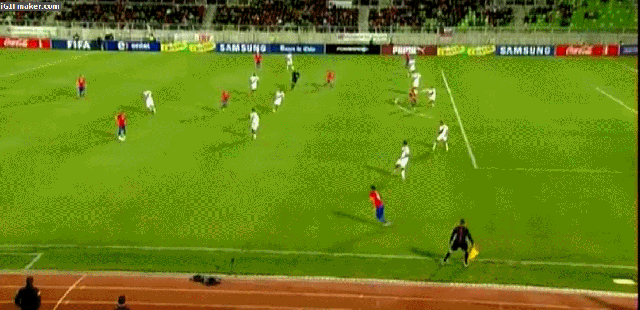
Thanks for reading! Feedback welcome and if you enjoyed, be sure to follow me on Twitter.






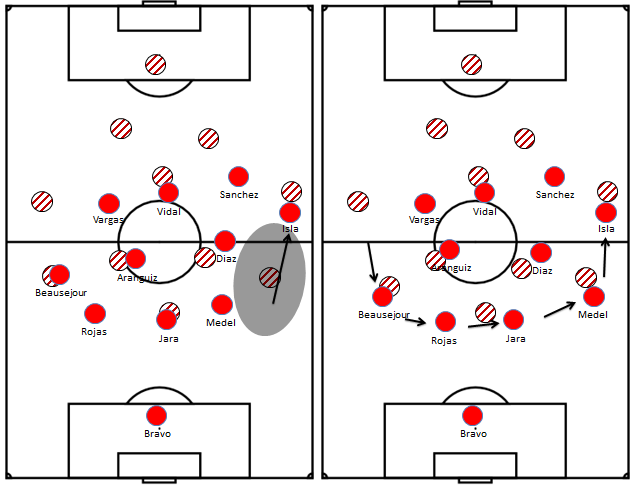
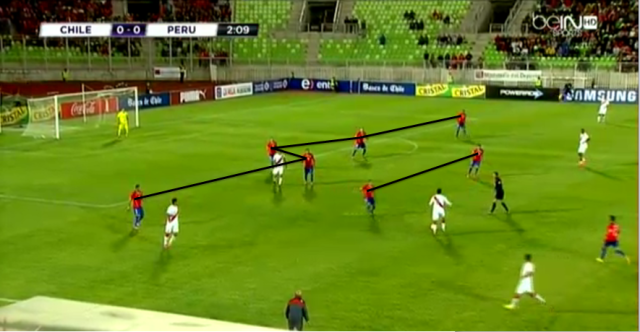
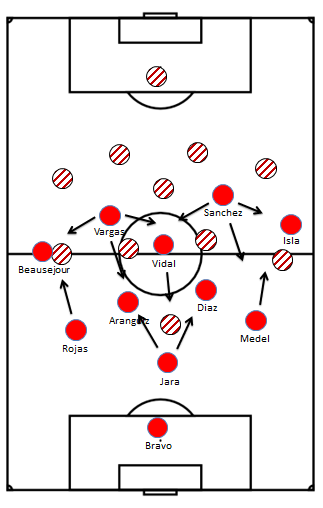
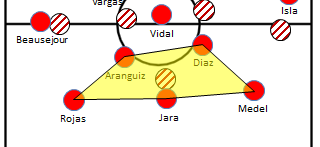
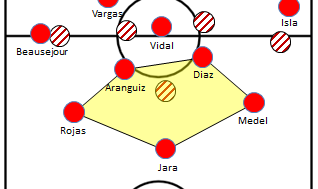
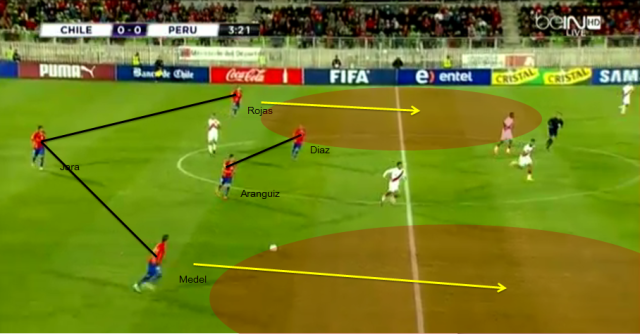
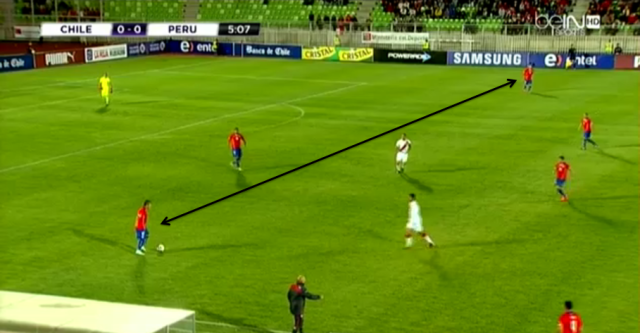
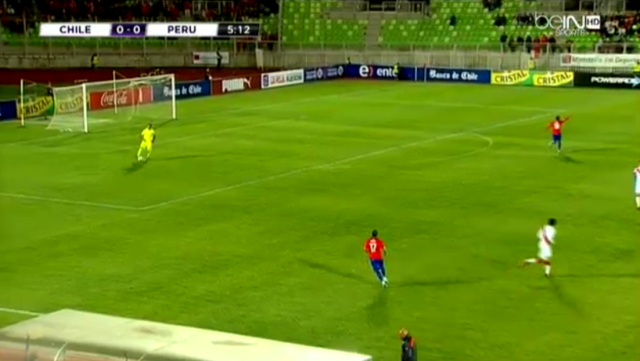
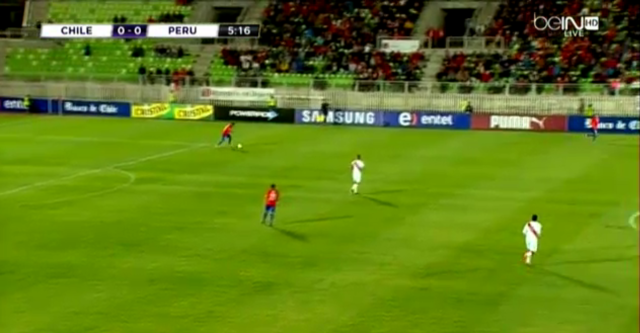
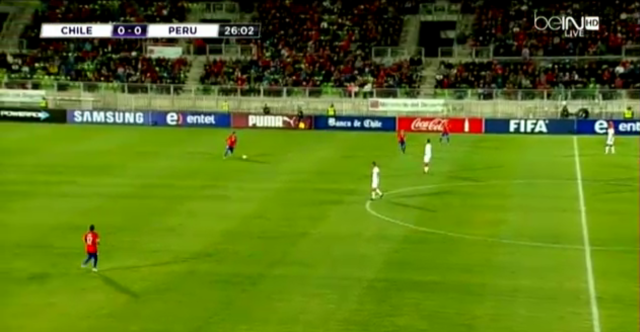
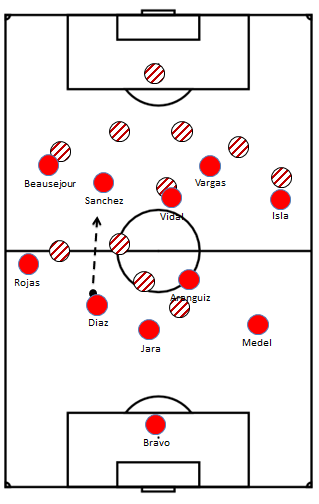
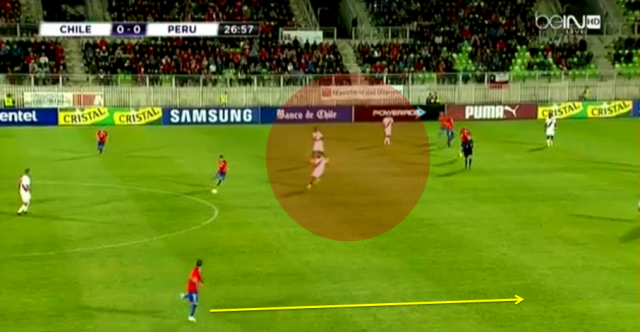
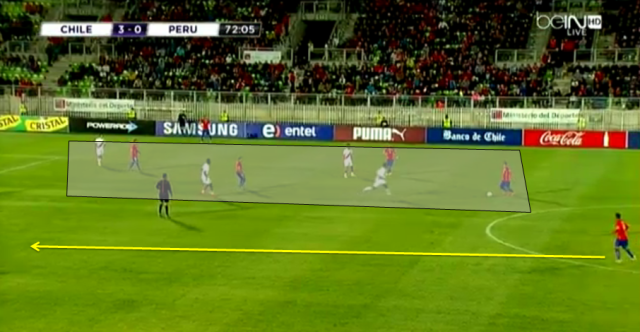
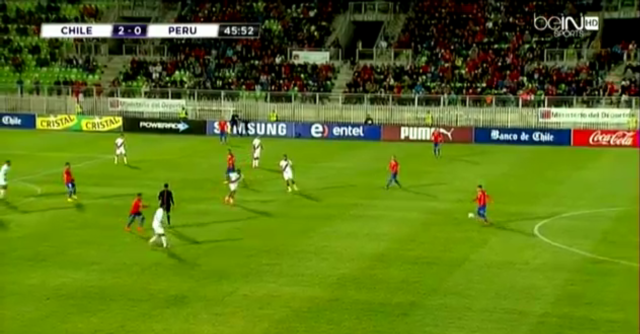

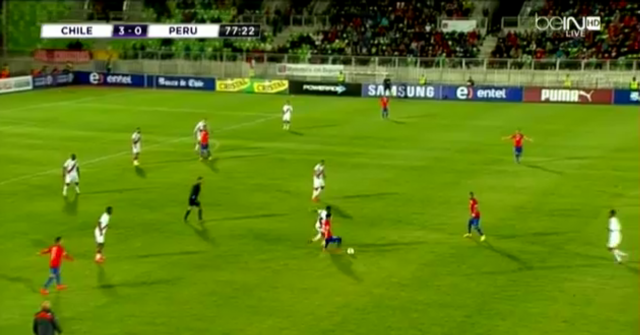
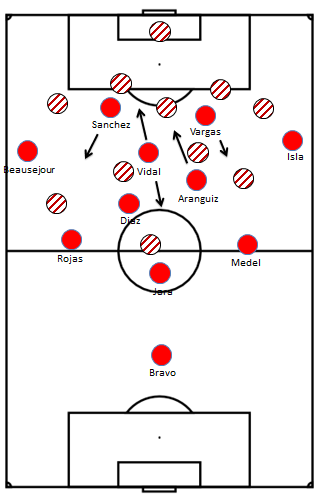

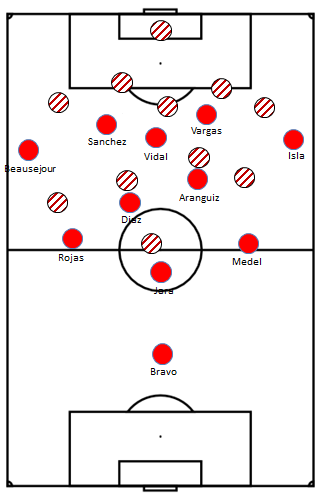
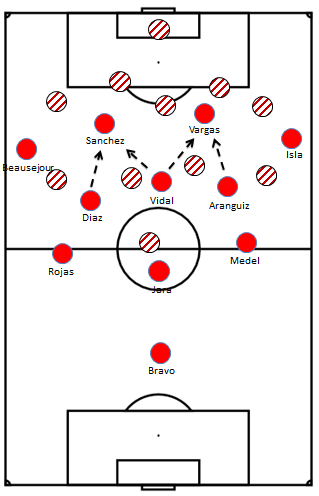
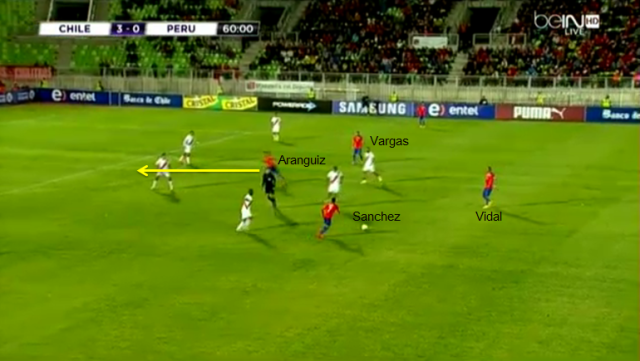
One of the best articles on tactics I’ve read. Very clear and instructive.Thanks!
Pingback: 7 cose sulla finale di Coppa America - Prestonews
I’m looking to play a 3-4-3 formation with my youth players. This is informative. I want to use a diamond midfield. With with provided by the wing strikers.